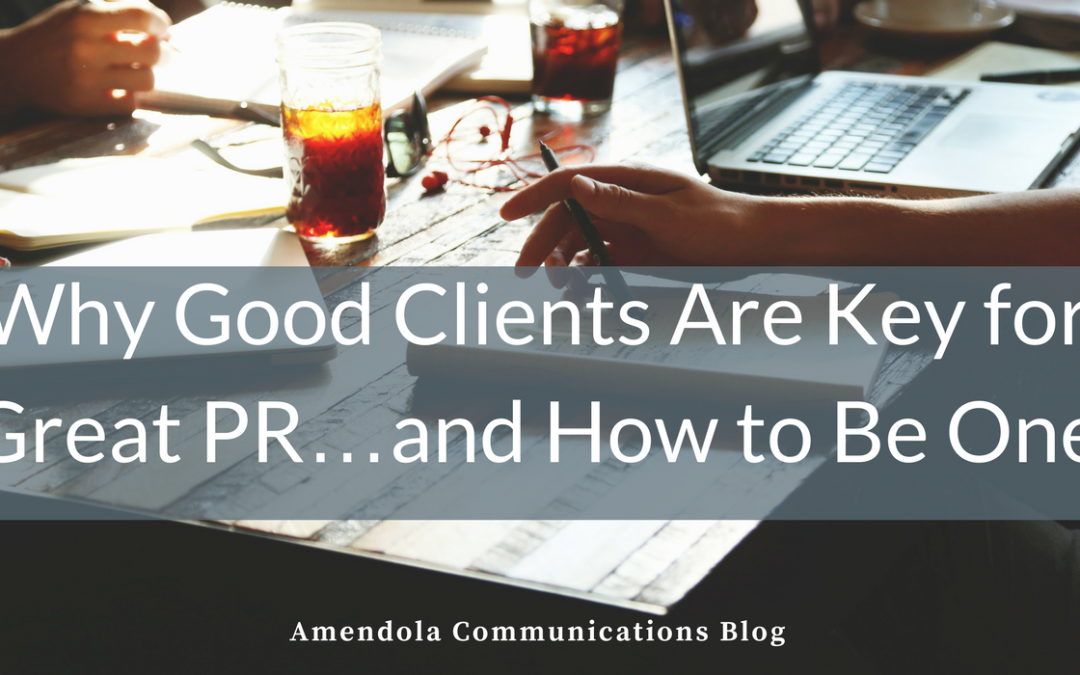
by Brandon Glenn | Aug 28, 2019 | Blog
For establishing thought leadership, there are few more effective tools in the public relations toolbox than byline articles.
Like the opinion column in the editorial section of our increasingly vanishing newspapers, the byline presents an opportunity for the author to share her personal take on a topic that is generating media attention or controversy. Generally, a byline represents the best way for an executive to showcase and explain her viewpoint in an in-depth manner to a targeted B2B audience of industry peers.
But writing bylines can be tricky. Publications are increasingly inundated with contributions, and several have changed their business models, now treating contributed bylines more like advertising meaning if you want to play, you have to pay. That means the media outlets that still publish contributed content can afford to be more selective than ever in terms of what they will accept, and some bylines will inevitably be rejected by editors.
To ensure your byline article doesn’t quickly end up in editors’ trash folders, make sure to avoid the following common mistakes.
Too self-promotional: For those unfamiliar with the nuances of bylines, this may be the most difficult concept to grasp: It’s not about you. The vast majority of publications expect bylines to be vendor-neutral, meaning authors cannot sell, promote or generally even mention their own company, products or services. Rather than viewing a byline as a means of converting your go-to sales deck to paragraph form, consider it an opportunity to share an inside perspective on a specific, well-defined topic of interest from an experienced industry veteran.
Doesn’t deal with an industry problem: While most readers who come across your byline aren’t interested in learning the intimate details of the widgets your company sells, they are interested in learning about real problems their industry peers have encountered and the steps leaders have taken to overcome those problems. That’s where the real value of a byline is found, in the straight talk of one industry leader providing others with an inside story of a challenging situation that they struggled (at least initially) to conquer. Extra points are awarded for honesty, clarity, surprise or even controversy.
So for example, a byline on the topic of “why hospitals need to account for patient’s social determinants of health” doesn’t have a great chance of pick-up, because everyone knows that social determinants are important by now. In contrast, an author could get much more mileage from a byline topic such as “why hospitals’ social determinants initiatives are doomed to fail without A, B and C” because that’s a topic that may tell readers something they don’t already know.
Too long: Renowned prize-winning authors may have the luxury of slowly setting a scene by painting a picture with words, drawing the reader in with multiple anecdotes and examples and then getting to the meat of the story. Business executives who contribute content to health IT publications are rarely granted that indulgence. In other words, keep it short. The sweet spot for a byline is about 700 to 1,000 words, and most editors prefer the shorter end of the spectrum. A good rule of thumb: If your byline exceeds two pages of a Word document, it’s time to make some edits.
Bylines are a wonderful tool for demonstrating industry expertise and thought leadership, but they can quickly go off-the-rails if authors don’t incorporate best practices. To interest readers (and editors) in your unique viewpoint, remember the above guidelines.

by Erik Yorke | Nov 14, 2018 | Blog
Many young organizations seeking to amplify their marketing and communications initiatives look to a public relations agency to help augment existing sales and marketing initiatives. But PR is not a one-size-fits-all discipline and it isn’t limited to media relations, as some still believe. Which means there are all types of ways to become a PR client.
Certainly, media coverage can be powerful, but is your organization built in such a way as to attract the kind of coverage needed to move the business needle? Or are there other facets of PR that you should consider that are more targeted and a better fit for how your business works? Let’s start by taking a look at what your current organizational strengths are.
Media Relations Why and Why Not?
Not all organizations are well-suited or prepared to generate media coverage. Earning coverage is already not an easy task, but can be impossible if your organization doesn’t have some key assets.
Asset #1 A Story
To get coverage in the media, whether it’s a trade publication or The New York Times, you need a story. The growing number of journalists publishing on the internet means there are a lot of places for you to potentially see your story. However, despite enthusiasm and passion within your organization for the projects, products, services and industry trends that you’re involved in, journalists often still don’t see the value to their readers. Some questions to ask yourselves that can help determine if your story is a winner for journalists:
How unique is your business or niche? If you do something that a lot of other companies do, or if you produce a commodity product, it will be more difficult to find a story hook.
Do you have SMEs that possess a truly unique experience and point of view on key trends? Personalities can drive coverage, particularly if you have people that are uniquely qualified to discuss certain topics.
Do you have customers in the healthcare realm this typically means providers that are willing to share experiences and outcomes either (or both) patient health outcomes and financial outcomes?
Asset #2 Data
Building off that last point top tier business journalists are always looking for data. They are a skeptical bunch, and claims of performance are not enough. Validation data represents something that media can sink their teeth into. All the better if you have a third-party such as a healthcare provider or a representative from a respected professional association share their data and perspectives on your story.
With those two key assets in mind, we can look at two very common asks that PR pros get from clients; interviews and content marketing.
Interviews
Every organization would love to have its leaders interviewed. But, despite the number of media publishing online, the amount of top-tier publications with editorial staff dedicated to doing interviews and writing in-depth stories is shrinking. That means that the ones that do interviews can be extremely selective. To stand out, you absolutely must have both of the key assets we’ve discusses a great story , and data to back it up. For B2B organizations, this almost always means linking the reporter up with a customer e.g. a physician, a hospital system executive, etc. that can speak to how a solution helped them solve a problem with data that supports the point.
If your organization has a difficult time coaxing customers to speak out on your behalf, interviews will be harder to come by. But there is another option that might work better.
Content Marketing
Such organizations may have a much more successful program if they lean more heavily into content marketing. By producing your own content and sharing it online, through social media, and through email marketing campaigns, you can control your message and time your stories based on your calendar.
Content is also a good alternative to interviews for these kinds of organizations. If your organization is staffed with a group of subject matter experts, you can often find a home for your story by writing it yourself. Most media are understaffed, yet still hungry for content, so bylined articles by your leaders are a great way to get your message out to targeted audiences.
Finding the right fit
Many, if not all, organizations can benefit from including PR in their marketing mix. It’s important, though, to have a good understanding of how your organization can best utilize PR for maximum success.
Setting out on a program heavily focused on media relations may not be the right fit if your organization doesn’t have unique and compelling data to support its claims of market differentiation. But even without a bench of enthusiastic customer champions ready to help you share your story, you can still find success through other channels, such as content marketing.

by Ken Krause | Apr 4, 2018 | Blog
One of the biggest changes that has happened in healthcare IT (HIT) public relations over the last 10 years is the increased demand for vendor-neutral byline articles, blog posts, and other materials.
It makes sense from the publications business model perspective. With ever-thinner margins they can’t afford to keep a legion of writers on-staff, or even to pay a legion of freelancers to write for them.
So, they supplement their own articles with content provided by various vendors. The caveat, of course, is that it must be vendor-neutral. In other words, it can’t overtly promote a particular company’s products or services. Instead, it must address a general industry topic, or adopt a general industry point of view.
While it makes sense to those of us directly involved in HIT PR, the idea of being vendor-neutral doesn’t always appeal to everyone within the organization. Especially those who are closest to the products, such as product managers.
“What’s the point of writing an article or a blog post if we can’t link back to our product (or service)?” they’ll ask. “Do we think customers or prospects will hunt for it on their own?”
While it’s easy to understand their concern, it represents transactional thinking. They expect readers will be so wowed by a product or service that they’ll click on the link immediately. And start engaging in the sales process.
That would be nice. But it doesn’t represent reality. Most products and services in HIT tend to have long sales cycles due to the cost, complexity, or disruption involved in replacing what an organization is already doing with a new solution.
That begs the question, “If the goal isn’t to secure a direct sale, then where’s the value in contributing the article at all?” Actually, there are several benefits.
Opening the conversation
In some cases, organizations who have been doing things a certain way for a long period of time may not realize they have a need. Or there is a different, better way to accomplish what they’re doing.
For example, a health payer may have systems and technology in place that enables them to process claims at a rate that keeps them profitable. But they may not realize they could be doing it in one-quarter of the time at one-eighth of the cost.
Or a provider may have analytics that are giving them a comprehensive view of what is happening in the organization. But they may not realize the same data could be telling them what to do next instead of looking back on what they’ve already done.
The vendor-neutral article or other materials become the opening salvo, alerting them to possibilities they haven’t even considered. That doesn’t mean they’re going to run right out with a credit card in their hands. But if they come to realize everything isn’t as hunky-dory as they thought, it creates an opening where none existed before. And guess who they’re going to look to when they start looking into solutions?
Establishing expertise around a topic
What if they organization realizes on its own that it needs to make a change? If the decision-makers don’t know how to address it internally, or they don’t have the resources to dedicate to it, most likely they’re going to perform some type of search to see who has expertise around that topic.
Returning results tied to articles from respected industry publications will have far more credibility than simply returning sales sheets. It will show your organization understands the problems HIT faces and is trying to help solve them. As opposed to your competitors who are simply trying to sell products.
Offering these vendor-neutral articles or other materials in a knowledge center on your website also helps establish your expertise. And your desire to work with them as a partner.
By demonstrating you understand what is happening within the big picture of healthcare, customers and prospects will get more of a feeling you’ll help them address their specific issues. Rather than just try to sell them whatever product you have that comes closest.
Once they feel you understand their needs, you can direct them to the product(s) or service(s) that address their issues.
Building your brand
Most vendor-neutral materials are created with the express desire to have an immediate impact on sales at some level. But they also provide another valuable function. They help build the brands of companies as well as the individuals attached to the materials.
Typically, we will ask clients what they want to be known for in a branding exercise. The answer is never a product. It’s always some sort of solution to an industry problem.
There’s no better way to get that message out there than to create materials that support this point of view. If you want to be known as the company that simplifies collecting from patients, producing a series of materials that explain what the need is and what needs to be done, at a high level, helps you capture that position. Especially if all your competitors are only offering up product-related materials on their own websites.
Establishing a strong brand gives buyers confidence that they are making a safe choice in a risky, uncertain world. That’s especially valuable for start-ups and/or companies venturing into new areas. You’ll be chosen more often if you look like the smart choice.
Accelerating the sales cycle
One of the least-understood aspects to public relations, especially in the digital age, is the value doesn’t come solely from the original placement. It’s what you do with the placement afterwards that really makes the difference.
A vendor-neutral article that has been published in a respected industry media outlet opens up all sorts of additional, sales-accelerating opportunities.
It can be added to your website, preferably in a knowledge center as mentioned earlier. That way, when a customer or prospect is looking around your website they get a sense that your organization is an industry expert, not just a seller of products.
It gives salespeople another reason to contact customers and prospects with a twist. An email that shares knowledge from company experts is far more likely to be read than another overt sales pitch.
Sales can use it both in an email blast to everyone and as an answer to specific inquiries, too. Imagine the power of a response that includes both the vendor-neutral article and the product or service that fulfills the needs the article lays out.
Vendor-neutral materials are perfect for sharing on social media. The organization can use its own channels, and even post in groups it belongs to (where appropriate). High-quality content will be of much greater interest than a product message that can be easily dismissed.
The more you use them, the more customers and prospects will become groomed to the idea that you have the solutions they need.
Taking the long view
For most HIT products and services, the sales cycle is a long one. It takes multiple touches, many of which will come before you’re even aware a buyer is interested.
Authoring vendor-neutral articles, blog posts, or other content helps you raise awareness of your organization. It also demonstrates you understand the challenges facing customers and prospects. It’s then a shorter leap to demonstrating how your products or services solve those challenges.

by Ken Krause | Jan 10, 2018 | Blog
One of the core tenets of journalism (and public relations, which at most colleges is part of the School of Journalism) is the use of AP style when writing. AP, of course, stands for the Associated Press, whose manual and rules are drilled into journalism students from the day they begin writing for their school newspaper (or whatever aspiring writers write for in school these days).
For a PR professional, use of AP style demonstrates that you are a journalism insider. That’s very important when you’re pitching a byline article, or a press release, or some other piece of content that needs to be reviewed and approved by an editor. It gives you a certain level of credibility, or at least signals to an editor that he or she won’t have to spend untold hours bringing your writing up to par.
Failure to use it, on the other hand, is generally seen as an admission that you are an ignorant hack whose writing skills would be best applied to warning labels on pet supplies. No one wants that.
This, of course, is the reason Amendola Communications is very careful about conforming to AP style. It benefits not only our agency but our clients.
Still, for those who aren’t familiar with AP style, some of its peccadillos can be a bit off-putting. They’re not used to seeing things written that way, and their preference for the approach they’re used to can become a bone of contention that slows down the writing and approval process.
Here’s the reality of the situation. When you are writing for your own blog, or marketing materials, or internal memos, etc. go ahead and let your preferences dictate the style. But when you’re writing something you’d like to have published by an independent media outlet, it’s important to follow AP style.
So what does that mean from a practical standpoint? Glad you asked! Here are five examples of the differences between regular people style and AP style. Those of you who are familiar with it please feel free to add additional common uses in the comments section.
Capitalizing corporate titles or not
This is the one that probably causes more consternation between Amendola Communications account managers and clients, so let’s start there.
Most people are taught in business writing courses to capitalize someone’s title, such as President, or Chief Medical Officer, or Vice President of Some Made Up Area that Sounds Good on LinkedIn. It’s viewed as disrespectful not to capitalize the title.
That is not the case in AP style. Titles are never capitalized, unless they are used as part of the person’s identity. Which means you can refer to President Trump with capital letters, but you would write Donald J. Trump is president of the United States.
This, by the way, is one of the easiest tests for editors and journalists to see who knows what they’re doing. Get it right in your press release and you’ve removed a barrier to publishing.
Spelling out acronyms
While the healthcare industry loves it some acronyms, AP style is not as much of a fan. So while you may believe everyone you’re communicating with knows EHR stands for electronic health record, AP style still demands that you spell it out anyway.
Usually, you will spell it out first, then put the acronym in parenthesis afterward, i.e., electronic health record (EHR). The exception is in quotes, which means if you’re going to use an acronym in a quote try to spell it out ahead of time, just to be safe. Of course, some acronyms that are widely known, such as FBI or CIA, do not need to be spelled out. But if you’re writing about them and you work in health IT, you probably have bigger issues than AP style facing you.
Bonus fun fact #1: According to the AP Style guide, using the initialism CEO by itself is acceptable, although they still recommend spelling it out somewhere else. Other titles, such as CFO or CMO, must always be spelled out because they are less universal.
Writing out numbers
This is another of those interesting AP style oddities. When writing out single numbers from 0-9, AP style dictates you spell out the number rather than use the numeral. So zero for 0, one for 1, all the way up to nine (9). Once you’re in double digits, you use the numerals, so 10, 11, and so forth.
That also applies to numbers used in combination, which can get very awkward. You would write “there are 10 three-bedroom homes on this block” or “Put the three of us down for 12 medical devices each.”
State abbreviations
The AP has its own set of state abbreviations that are preferred, especially for use in a dateline. They are different (and longer) in most cases from the more-familiar postal codes, so it’s worth looking up. Or, you can just follow this link, although they’re not laid out quite as nicely as you might like.
Here are a couple of examples. The postal code for California is CA, but the AP style abbreviation is Calif. The postal code for Arizona, where Amendola Communications is headquartered, is AZ whereas the AP style abbreviation is Ariz.
Two-word states tend to get different treatment. While New Hampshire uses an N and an H for both, the postal code is NH while the AP style abbreviation is N.H. The extra periods make a difference.
Bonus fun fact #2: When you’re in the body of a press release, AP style stresses spelling out the name of the state rather than using abbreviations of any kind.
Bonus fun fact #3: Certain large cities, such as Chicago, Los Angeles, Phoenix, and New York, don’t require a state at all in the dateline. In fact, including a state again makes you look like you don’t know what you’re doing.
Other types of abbreviations
For pretty much any other type of abbreviation, you’re always going to use periods after each letter. That includes professional credentials (M.D. instead of MD, Ph.D. instead of PhD) and time designations (p.m. instead of pm, E.S.T. instead of Eastern Standard Time).
Yes, it can be very odd-looking, especially when you say an event will begin at 1:00 p.m. E.S.T., and yes, all those periods kind of get in the way. But that’s the way, uh-huh uh-huh, they like it. (Sorry, channeling my inner Kate Donlon there.)
So many rules
This is just a small sampling of some of the most common issues that seem to crop up from time to time. There are many more. In fact, the AP puts out an entire manual with everything you could possibly wonder about, which they will be more than happy to sell you if you’re interested. It’s available in both paper and electronic form.
Or, you can just count on your friendly neighborhood PR pros to get it right for you. It’s all part of the service.




